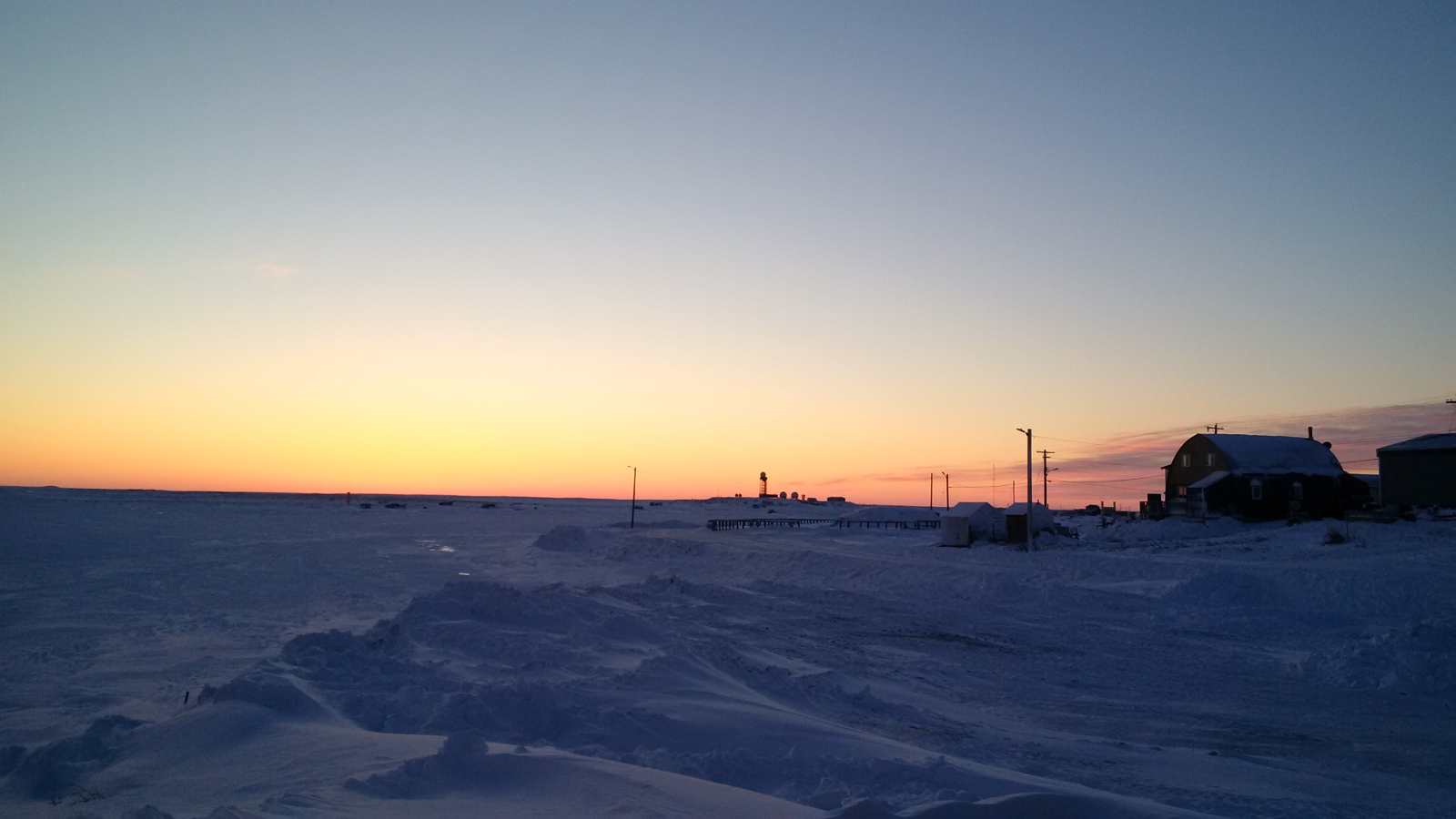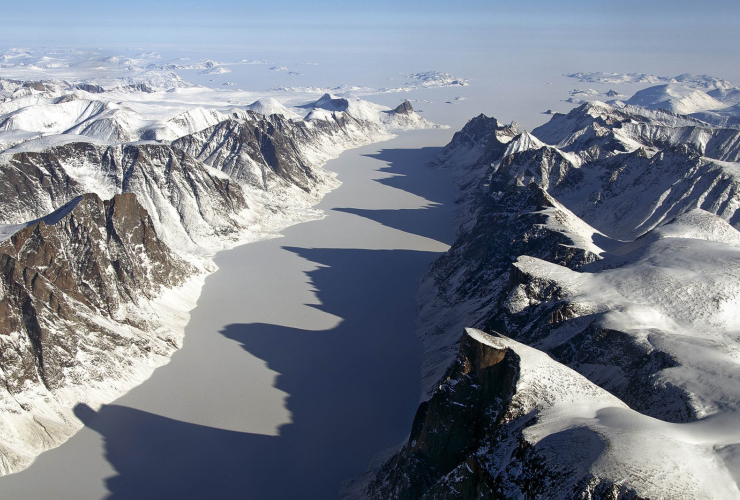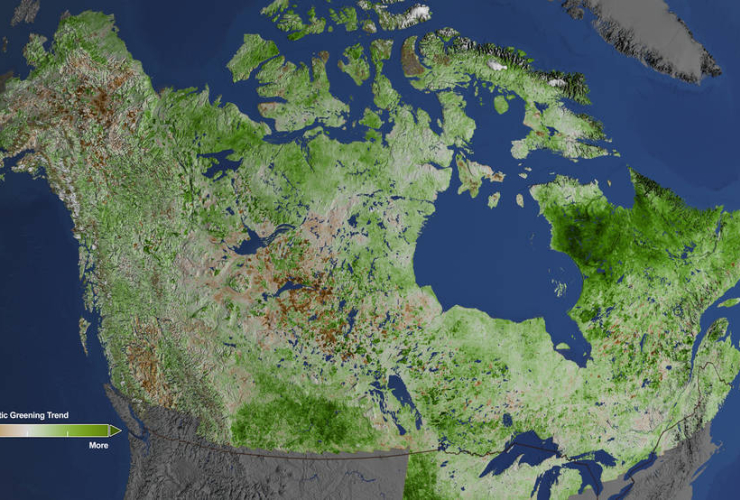On a cool wet morning in Tuktoyaktuk, I rode with the polar bear hunter. His name was James Pokiak. When his daughter, Rebecca, told me he would pick me up at Tuk’s only B&B, I half-expected a bearded northern Zeus to arrive on a sled pulled by stags sporting a vest made of oxen wool and an antler headdress. But James drove a Ford F350 and wore a hat from Disneyland. He was also more compact than I might have thought, with smiling cat eyes and a thin moustache, sitting low behind the wheel as if the hulking truck was driving him.
Because we only had part of a day together, I asked the polar bear hunter, who’d just turned 61, if he would start by regaling me with a few harrowing tales of stalking the greatest of northern beasts, of which two-thirds of the world’s population live in Canada. “Well,” he said, looking over as if to ostensibly measure my ability to stomach what he was about to say, “polar bears are, you know, pretty shy.” It was the equivalent of Dark Vader tittering through his faceshield: “Jedis? I dunno. I think they’re kind of cute.” Perhaps sensing my disappointment, James continued: “Well, there was danger a few of the times, sure. But, you know, nothing we couldn’t get out of.”
“You make it sound like anyone could do it, even me,” I told him, waiting to see if he would pull the car over to hold his side while laughing.
“It’s true that I had to take a few bears at the tent after they’d gotten close,” he said, “and it was pretty scary. But the adrenalin rush pushes you, and you do what you have to do. Still, polar bears are not as aggressive as grizzlies and they’re usually pretty timid,” he continued, the softness of his voice making the beasts-- and the idea of taking them-- seem as benign as picking up a hamster from the carpet.
If Diefenbaker slept longer, he would have got to Tuk
The matter of polar bear sport hunting in the north-- a business that had suffered recently due to U.S. restrictions on importing pelts-- was a hot topic of discussion on the porches and in the community halls of the small hamlet at the heels of the Arctic Ocean. The issue was tied to what was about to happen to the town, and how it would open up the place to visitors, many of them prospective hunters: the first permanent all-weather road into Tuk and a de facto completion of the Trans-Canada and Dempster highways. People in town talked about “the road” more times than at a Cormac McCarthy book club. It was a remarkable development in a region-- the North-- that had seen many unprecedented developments over the last few decades after centuries of relative stasis: renewed oil exploration, the birth of Nunavut, the push for Arctic sovereignty, the effort to discover whatever remained of the Franklin expedition, and a general rise in the nation’s consciousness about the white land mass that stretched above them. The all-weather road-- 120 kilometres long and slated to open in 2017 at a cost of $300 million (mostly covered by the federal government) -- would allow a generation to experience that which their ancestors never could: escape. Some, like Eilleen Jacobson made comparisons to the Dempster. “They say that (former prime minister John) Diefenbaker dreamed the Dempster highway,” she told me. “I say he should have slept longer. That way he would have got to Tuk.”
The road would provide a way out for citizens after an eternity of having to deal with the absurd costs of air and boat travel-- a round trip cost $400 for an eight minute flight from Inuvik-- as well as the risk of navigating the 35 km winter-only ice road, which took two hours to drive and where a speeding ticket was $800. The new road would link Tuk to Inuvik, but really, it would sew Tuk into the rest of Canada and the world. Year round ground transportation meant a constant flow of supplies to town and access to a demographic of tourists who didn’t have to save for a lifetime to afford the airfare required to travel north.

The construction of the road would happen slowly, and only in the wintertime, allowing trucks to carry 40 ton loads across the ice. Special geotextiles had been developed to protect the permafrost with an eye to how the land might change-- or, rather, melt-- with rising temperatures, a condition exacerbated by warm run-off in the early summertime. According to a piece written by Chris Windeyer for the Yellowknife’s YK Edge, “At one of the sites, crews (plan to) install plastic culverts instead of metal ones. (It) may not sound like exciting science, but the idea is to reduce the amount of heat that gets into the roadbed via the corrugated metal used in traditional culverts. At another site, scientists from the University of Manitoba will build an embankment with layers of gravel and geotextiles. The whole thing will be laced with sensors to study how much the surrounding soil moves.”
"It's so much harder to find places to hunt and fish down there"
A report prepared by the Northwest Territories government for the region suggested that the road would increase tourism spending by $2.7 million per year - an extravagant number considering that the unemployed and the elderly spent no more than $70 per month to rent their subsidized homes, and the average personal income was just over $35,000 per year. Merv Gruben told the Globe and Mail that, “we need the hotels, we need the RV parks, we need the garages. We have to expand our schools and our health centres. Tuk’s never going to be the same again. It’s got to expand. A lot of people will be moving here; families will be moving back here.” Merv added to this over the phone, telling me: “The road will let people see part of their land they’ve never seen before. Just after we started putting the road in, I took some elders for a drive out there and they wept, having set eyes on parts of the land they’d never been able to see before.” In the polar bear hunter’s eyes, the road would make it easier to get into the community, “but it will be easier to get out, too,” he said. “It works both ways, you know.”
I asked him if he was worried that people would be inclined to leave Tuk forever-- partly recognizing the road as a symbol for my own worries over the Internet and its affect on newspapers and journalism-- but James said, “No. Even if people leave, they will always come back. Right now, we’re stuck and it’s too expensive for most people to fly. With the road put in, a family of five or six can travel a lot easier. Besides, there are lots of young people sitting around doing nothing for themselves, and there’s a whole world out there. When the road opens, it will give them motivation, but it will also show them how lucky we are to jump on a snow machine. They’ll also appreciate what it’s like to be here. That’s my hope, anyway.”
“So you’re not worried that they’ll go to the cities and want to stay?” I asked.
The polar bear hunter laughed gently.
“Why would you want to do that? It’s so much harder to find places to hunt and fish down there.”
Connecting all three oceans
When James spoke about the road-- its invasiveness after years of isolation-- you could see him trying to collect his thoughts as if arranging a set of puzzle pieces. “The road will bring a whole new set of opportunities for us,” he said. “But I’m concerned with how close it is to the Husky Lakes (aka Eskimo Lakes). There’s good fishing there and I’m worried about how it might affect the quality of the water. A long time ago an oil company wanted to come in here and build a road and we said ‘no.’ But times have changed. People seem more willing to try it.”
Doug Matthews, an energy writer long involved in northern issues who was living in Tuk with the purposes of readying the town for the opening of the road, said: “The highway will present a large psychological challenge and the hamlet has to be prepared for it. Right now, for instance, our office closes at 2 pm on Fridays, but with the opening of the road, people will be able to come into town any time they want. We’re putting together funding for programs that will help prepare people for this. We’re talking to elders, priests, students; alerting them to the enormous changes that are about to come.” I asked Doug if there was a fear that it would be a little like having an open house and suddenly becoming aware of all that’s wrong with where you live. “Yes,” he said. “People have been living here naturally, isolated from everything else, and, suddenly, there will be strangers coming to look around; lots and lots of them. The trick is to make people feel less self-conscious or worried about the appearance of the place, yet at the same time be careful that it doesn’t look too weathered or ragged. I mean, we’ve got all of these old fuel tanks everywhere. Nobody ever thought anything of them before, but, frankly, it’s a good reason to paint the fucking things.”
Doug shared in the romantic notion that the road would, finally, connect all three oceans-- Pacific, Atlantic and Arctic-- and he felt great symbolism in the fact that it would harmonize with Canada’s sesquicentennial.
“It’s the equivalent of a modern-day last spike,” he said. “It’s the final tie between the people up here and the rest of the country. I think that’s reason enough to celebrate it and give it focus, as opposed to simply dwelling on how the town will change. It’s also symbolic that the road, itself, is being built by two Inuvialuit companies-- E. Gruben’s Transport and Northwind Industries-- and the planning is all being done locally. This is a northern effort. It’s not as if people are being airlifted in and outsiders are telling everyone what to do. There’s a entrepreneurial crowd here, and there always has been. The skills that made the Inuvialuit self-sustaining traders and hunters can be applied, and the fact that the community has been around as long as it has bodes well for whatever changes the road presents.”
The other change-- or potential change-- that loomed on the horizon was the potential for greater oil and gas exploration. Locals had seen this film before, based around a dalliance between heavy industry and the almost chimeric-- some would say cursed-- prospect of bountiful natural resources.
Is this a new road to oil?
Imperial Oil had been the first to discover oil in 1970 in the waters of Tuk Harbour, kickstarting the Beaufort Sea exploration programs of the 1970s and 1980s, with Dome Petroleum, Gulf Canada Resources and Esso Resources all operating out of the harbour and its shore-based facilities. The town benefited, if modestly, from municipal infrastructure, a few new roads, improved waste management sites and an extended airstrip, but collapsing world oil prices in the mid-1980s and the cancellation of the National Energy Program stopped any further work in the region. Companies pulled out, leaving the casks of old equipment and off-shore stems that you could see from the shoreline, and, in the end, all the promises-- no matter how divisive or conflicted within the community-- were just that. Author Kenneth Coates has called it “a northern vision gone sour,” although the windscreen was always too muddy to know what lay at the end of the road.
Still, interest renewed in the area in the mid-2000s, and over the past ten years, billions of dollars of exploration parcels have been awarded to BP, Esso, MGM Energy and Conoco, among others. One of the conspiracy theories I’d heard floated, both in Inuvik and here, was that the new road was part of the oil companies’ demands, as well as certain international interests looking to acquire future water rights. It was hard not not to see that an all-weather road would increase corporate accessibility while decreasing the cost required to be here, and the same applied to a deep water port, which some said was required to facilitate tanker traffic, and even cruise ships, one of which appeared every summer, its passengers ferried into Tuk by motor boat. Merv Gruben, the former mayor of the hamlet and one of the main champions of the road, said that “With the opening of the Northwest Passage, and with there being no port between St. John’s and Dutch Harbour, the road could prove vital to getting goods down from the north and to the west. If the port is expanded, we can provide service to whatever is happening offshore. We could be a supply point for fuel and oil.”
When I asked how he felt about this, the polar bear hunter’s face grew hard and he said: “Shell, Chevron, BP; they all attempted to drill before, but they failed environmental impact screenings, and nothing shows me that they won’t again.” To him, industrial development wasn’t the inevitability that others thought it would be. “What if what happened in the Gulf happened here?” he asked, shaking his head. “There’s no answer to the blow back and the majority of our livelihood and food source would be destroyed. The fish, seals, and whales would disappear. The tailing ponds in Fort Mac are so big you can see them from space, and they’ve already found toxins here, in the MacKenzie river. You get a simple rainstorm and the runoff is increased. I’d be completely happy if nobody drilled in Tuk Harbour.”
I read him parts of a Globe and Mail story in which an Inuvialuit man, William Dillon Jr., commented on the 1970s legacy of oil companies by saying, “They train us, and then they disappear. They come back again with another idea, creating work, and then they start to train us again. That tapers off. The money runs out and then they disappear again: boom and bust, boom and bust, every year.”
James nodded and said: “The drilling would create jobs, okay, but new wealth would affect things like crime, drugs and alcohol (at present, Tuk is a dry town), and because we’re a small place, it would change fast. It would hurt our hamlet. We don’t need it.”
While the future of Tuk - and the greater north - hangs in the balance, the numbers cast shadows over everything: 12 billion barrels of oil buried across the Territories, Nunavut and Yukon; seven million hectares of land under permit or lease in the same area; a 7,000 kilometre decrease in distance that a ship would save by taking the Northwest Passage for a trip from Tokyo to London; and the highest per capita unemployment rate in Canada: 12.3 per cent in Nunavut; 7.6 per cent in the NWT; and 6.9 per cent in Yukon. While it’s true that lack of progress concerning Northern Gateway and MacKenzie Valley pipelines as well as the sinking price of oil had slowed the thunderous footsteps of change, I got the sense that people in Tuk - like newspapers and writers - knew that something was coming. The only question was when, and for how long.
A great article - thank you
A great article - thank you so much ! Hopefully Tuk and Polar Bear Hunter will be able to weather the onslaught and retain their culture.
Barbara,
Baja California, Mexico
elkehlx
elkehlx
http://www.albatrozsecsa.com.br/akaimibr/home/content.asp?xx=199-igf-1-l...
http://www.harboursales.in/Scripts/class.php?kkl=185
http://www.building.com.br/admin/excluir.asp?ss=81-kigtropin-reviews-201...
http://www.artigianipiacenza.it/wordpress/contact.asp?m=84-Tillväxthormon-Att-Köpa-Ansomone-Hgh-Price-Tillväxthormon-Till-Barn-Biverkningar
http://www.melogranosalute.it/mailing/main.asp?page=162/
Ansomone Hgh Side Effects
jintropin price in india
Гетропин Ру Отзывы
hgh canada pharmacy
igf lr3 or des
Riptropin Hgh Fake
Riptropin Hgh Fake
To combat sensing unmotivated, remain shifting by setting little desired goals with real rewards. This will enable you to savor the results of your own effort more rapidly and more commonly. Trying to keep tiny desired goals entails that this occasional skipped objectives will probably be quicker to overcome, maintaining yourself esteem higher.
buy jintropin
Acne could be a very difficult condition to manage. To start with, it really is deforming in most cases the pimples are most obvious on the face. Many people feel once they just eat correctly and thoroughly clean their skin properly it would go away, but the provider is actually on the inside. A skin specialist can prescribe treatment to aid.
human growth hormone pills
Connect some movements sensing nighttime lights. At the very least, you should look at plugging in one in every strategically situated wall plug involving the sleeping rooms and also the toilet. You can now get these lights at the $ merchants for very inexpensive rates. Think about the reassurance they will offer!
buy jintropin from china






Comments